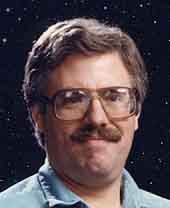|
Rick Sternbach
–
space artist
|

|
"
For me, the real drive to draw and paint space subjects is inextricably tied to a desire to explore..."
|

|
| |
|
|
|
| |
How were you motivated to choose your particular field? |
| |
The original inspirations came almost twenty years before I discovered that I could actually produce astronomical and space hardware illustrations, and hope to make a career out of doing so. The most striking ones include the Disney "Man in Space" series of short animated and life-action documentaries produced in the 1950s; books and magazines covering the International Geophysical Year (IGY) of 1957-1958; illustrated books about space travel and planetary exploration with paintings by Chesley Bonestell, Mel Hunter, and Jack Coggins; and most every 1950s-era science fiction film -- good or otherwise -- which depicted flights to other worlds. Forbidden Planet would certainly have to rank high on the list of imaginative films that works almost as well today as when it was released in 1956. Drawings, blueprints, and models of proposed spaceships were beginning to fill scrapbooks and shelves for many of us who grew up in this period.
Complimenting the media and scientific influences in the early years was the influence of my father, Paul Sternbach, an architect in Stamford, Connecticut. He provided me with the essential set of tools with which to see the world, understand how machines work, and how to convey ideas through drawings and paintings.
The 1960s certainly produced volumes of visually striking images from both unmanned and manned space missions. Artists were concentrating on showing us how Apollo would get us to the moon, and the sleek, swept-finned spaceships of the decade before gave way to corrugated tanks and gimbaled nozzles. I drew every chance I got, built models, and came to learn about rockets and space systems from the late G. Harry Stine, whose fact and fiction writings I later illustrated. Only a few years before embarking full-time as a space and science fiction artist, I was privileged to witness the launches of three Apollo lunar missions, 11, 13, and 17 from the press site and environs of the Kennedy Space Center.
For me, the real drive to draw and paint space subjects is inextricably tied to a desire to explore, to dream up devices and destinations previously unimagined, contribute to today's missions, and hopefully influence others to continue the outward reach.
|
|

|
| |
|
|
|
| |
What can you share about your creative process? |
| |

|
|
The part of the process of producing a new piece of art that I find most exciting and enjoyable, whether it be space art for publication, visual effects design for a series like COSMOS, or science fiction hardware in my work for Star Trek Voyager, is the act of creating something almost from thin air. Marks on a blank sheet of paper or cuts in a sculptural solid object can be manipulated in limitless ways as the picture in one's mind can be set down for others to see. This has been the artist's way for thousands of years. For the contemporary space artist, knowledge of science and engineering blend with the ability to commit shapes and colors to canvas and computer screen, with the final product able to function on many levels, from a basic work of art to a tool to help accomplish a greater goal.
I am constantly drawing upon images from nature, past and present technology, mathematics, news reports, everyday shapes, music, and artistic styles from other cultures and historical periods. A simple doodle may evolve into a complex piece of hardware or an impossible piece of geology. A breakthrough in high-energy physics may trigger a visual composition of another world and spacecraft to get us there.
A simple blue pencil and a pad of paper can become a powerful springboard for the imagination, as the mind absorbs and filters and processes, and the hand creates. Over time, clearer and more complex versions of drawings and paintings and computer renderings appear, as if from thin air.
|
|
| |
|
|
|
| |
What ideas do you have for a future human community on Mars?
|
| |
I have no special visions for the Mars community of the future that haven't already been imagined for the past fifty years or more. Even if I am not able to witness the first human landing on Mars –– though I have no doubt that it will happen before 2030 –– I will hope that any permanent settlement will be built to accommodate growth and to be flexible enough to change as the community discovers different and better ways of doing things. Colonies on other worlds have been likened to Antarctica with multi–national bases, as breakaway independent states, or as exploiters of unlimited natural resources. Anything is possible.
But for the Mars community to become a true representative of civilization, its citizens, by the very nature of their positions and like the systems of the spacecraft that brought them, will be required to work together, solve problems, and survive. Mars will not be opened to habitation as quickly as land rushes attempted to open the western United States; that haste cost human lives. Lessons learned aboard Mir, ISS, and all long-term space flight to come will add invaluable knowledge to our ability to maintain a viable presence on Mars.
|
|

|
|




